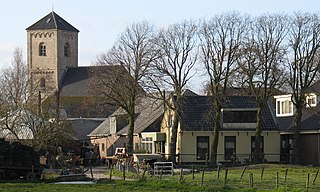
Haarlemmerliede en Spaarnwoude is a former municipality in the Netherlands, located in the province of North Holland. It had a population of 5,760 in August 2017. On 1 January 2019, it merged with the municipality of Haarlemmermeer.

Haarlemmermeer is a municipality in the west of the Netherlands, in the province of North Holland. Haarlemmermeer is a polder, consisting of land reclaimed from water. The name Haarlemmermeer means 'Haarlem's lake', referring to the body of water from which the region was reclaimed in the 19th century.

Wezep is a town in the municipality of Oldebroek, Netherlands. Located in the province of Gelderland, it had about 13,500 inhabitants in 2012. The Wezep railway station, located on the Utrecht–Zwolle railway, is the town's main landmark. The municipality's TV station is called LOCO TV.

Sloten is a village in the Dutch province of North Holland. It is a part of the municipality of Amsterdam, and lies about 6 km west of the city centre.

Burghsluis is a hamlet in the Dutch province of Zeeland. It is a part of the municipality of Schouwen-Duiveland, and lies about 22 km north of Middelburg.

Stroodorp is a hamlet in the Dutch province of Zeeland. It is a part of the municipality of Noord-Beveland, and lies about 11 km northeast of Middelburg.

Doel is a subdivision of the municipality of Beveren in the Flemish province of East Flanders in Belgium. It is located near the river the Scheldt, in a polder of the Waasland. Since 1965, there have been plans to extend the Port of Antwerp into Doel and demolish the village. However, protests have caused a stalemate. On 30 March 2022, a deal was reached and the village is allowed to exist.

Stroe is a village in the Dutch province of Gelderland. It is located in the municipality of Barneveld, between the towns of Barneveld and Apeldoorn.
NDSM is a neighborhood in Amsterdam, Netherlands located on the former terrain of the Nederlandsche Dok en Scheepsbouw Maatschappij (NDSM) shipbuilding company. It is located in the Amsterdam-Noord borough along the IJ river and can be reached by ferry from Amsterdam Centraal station. After the shipyard closed, the various buildings were occupied by squatters before being gentrified in the 2000s, becoming offices for groups such as Greenpeace, MTV, Pernod Ricard, Red Bull and ViacomCBS. The East part of the former wharf houses a large number of art galleries and festivals throughout the year. The IJhallen is the biggest flea market in Europe, it also houses various populair restaurants Pllek, IJver, Loetje aan het IJ, Noorderlicht, Next. NDSM-West is redeveloped as a mixed-use residential area with high-rise buildings up to 120 meters. By 2034 NDSM-West will have 5000 residential units. NDSM-Oost will be redeveloped into a city park with art galleries and the monumental buildings.
Baalhoek is a hamlet in the Dutch province of Zeeland. It is located in the municipality of Hulst, about 5 km east of Kloosterzande on the dyke of the Westerschelde.

Belt-Schutsloot is a village in the Dutch province of Overijssel. It is located in the municipality of Steenwijkerland, about 3 km north of Zwartsluis.
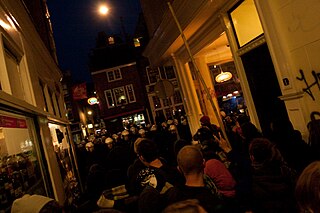
The Dutch squatting ban refers to the law introduced on 1 October 2010, under which squatting in the Netherlands became de jure illegal. Criminalization had first been proposed in the 1970s, but was opposed by the Council of Churches. In 2006, a new plan was proposed and backed by parties including VVD and PVV. When the new law was introduced, squatters occupied the former head office of the fire brigade and there were riots in Amsterdam and Nijmegen. In 2011, the Supreme Court of the Netherlands ruled that the legally forced end of squatting can only occur after an intervention of a judge. Between October 2010 and December 2014, 529 people were arrested for the act of occupying derelict buildings, in 213 separate incidents as a result of which 39 people were jailed.
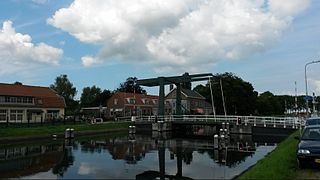
Wilhelminadorp is a village in the Dutch province of Zeeland. It is located in the municipality of Goes.
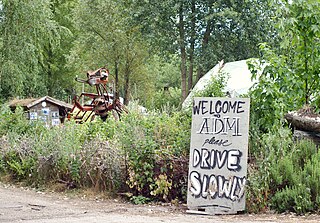
ADM was a squat in the Port of Amsterdam, to the west of the city next to the North Sea Canal. The squat lasted from 1997 until its eviction in early 2019. Around 130 people lived on the terrain of 45 hectares in buildings, on boats and in vehicles.

We Are Here is a collective of migrants based in Amsterdam, the Netherlands, which campaigns for human rights for its members and all undocumented migrants. The asylum seekers have in many cases had their applications to remain in the Netherlands denied but they either cannot go back or refuse to return to their country of origin. They demand access to social services such as medical care and housing. The group formed in 2012 and by 2015 contained over 200 migrants from around 15 countries.

Vrankrijk is a legalised squat and self-managed social centre on the Spuistraat in central Amsterdam. There is an events space on the ground floor and above it a separate housing group.

Squatting in the Netherlands is the occupation of unused or derelict buildings or land without the permission of the owner. The modern squatters movement began in the 1960s in the Netherlands. By the 1980s, it had become a powerful anarchist social movement which regularly came into conflict with the state, particularly in Amsterdam with the Vondelstraat and coronation riots.

The Tabakspanden are a group of buildings standing on the Spuistraat in central Amsterdam, adjacent to the Keizerrijk and Wijdesteeg alleyways. Named after a former owner, the speculator Hendrik Tabak, they were mostly squatted from 1983 onwards, although the artist Peter Klashorst also rented an apartment and gallery space. The best known building was Spuistraat 199, known as the Slangenpand (Snakehouse) because of the large mural which covered the front exterior. In 2015, the squatters were evicted and the buildings were mostly demolished prior to redevelopment. The new project is known as De Keizer and has 69 apartments, a restaurant and a gallery. Two of the buildings are registered as rijksmonumenten.
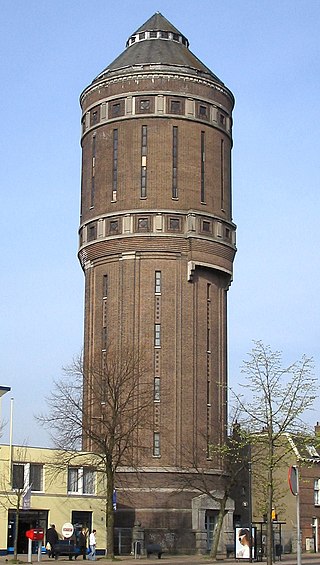
The Amsterdamsestraatweg Water Tower is located in Utrecht, the Netherlands. The water tower was built at Amsterdamsestraatweg 380 in 1916, in the style of the Amsterdam School. It became derelict in 1986 and was repeatedly squatted before its redevelopment into apartments began in 2020.
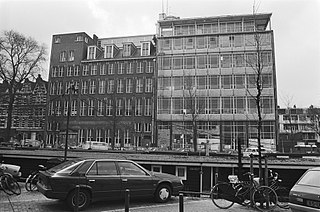
Tetterode is a complex of buildings in Amsterdam-West in the Netherlands. Built as the Amsterdam Type Foundry from 1902 onwards for the Tetterode print company, the site was left derelict in 1980. After plans were announced to demolish the buildings, they were squatted in 1981 and later legalized in 1986. Tetterode hosts or has hosted a range of activities including an art gallery, arts and crafts workshops, a citizens advice centre, a clothes shop, the Eddie the Eagle museum, a gay and lesbian disco, a hairdresser, a kindergarten, a stencil printers, a shoemaker and a theatre. In 2021 it celebrated its fortieth anniversary.






















